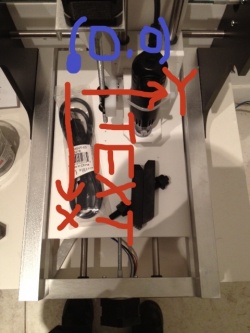Desktop CNC Mill
This machine is not currently present at the space.
Materials
This is the coordinate system you get if you use the default settings from the manual (with inverted Z axis):
The configuration file may give you a different system.
- File:MyDIYCNC Comprehensive Plans and Manual eBook 1-4.pdf
- File:MyDIYCNC.stepconf.zip
- Additional settings when using this conf:
- Base Period Max Jitter: 17104
- Disable pins 10-15 (end stops)
- Z axis: -100 to 100
- In pycam -- tool diameter (for dremel center mill tool) is 2.86mm
- Additional settings when using this conf:
Introduction email
TODO: Cleanup
There is a CD in the desktop which is the live CD for the special RTLinux LinuxCNC/EMC2 version of Ubuntu that is required. You can use the wizard to set up LinuxCNC according to the instructions. Note that we are using a PCI parallel port so the default 0x378 I/O address for the parallel port address is incorrect. Find it in dmesg; when we tested it, the address was 0xcf00.
- Z axis direction needs to be inverted (it's not in the manual)
- Remember to invert all the digital outputs! They're actually the enable pins.
- Don't forget the 0.4 in/s maximum speed on each axis.
Or try the configuration file linked to above.
Note that the maximum Z height is 0, which should be homed for just above the workpiece. If you just mill the standard EMC2 logo, after homing Z (and the other axes), use the Touch Off button to indicate how far down you want the tool to go. Type in a *positive* value, for example 0.25 for the tool that's currently mounted. The EMC2 logo already goes down 0.1 inches, I'm not sure what the relationship is between this number and the touch off distance.
When moving the toolhead manually in the GUI, remember that you can change the speed with a slider.
If you follow the manual and don't invert the X and Y axis directions, beware what's home and what direction it will go. In the photo, I have indicated the X and Y directions of the tool on the workpiece; the actual bed will go in the opposite direction. Also note that the designers of this mill don't have the same idea of X and Y as the rest of us. The big blue dot indicates where you would put the origin of the coordinate system.
There is a knob on the rotary tool that is used to set the speed. The tool should actually be turned on and off inside LinuxCNC/EMC2.
The wires are currently not routed in a very good way. If you are going to be using the mill a lot, feel free to do some good routing, and cut off / add any zip ties you want.
It would be great if someone would resize the existing file system so we can install the LinuxCNC version of Ubuntu permanently.
The parallel port wires from the ribbon cable are really too thin for the screw terminals. Sometimes they come loose. Daniel added a dab of solder to one of them.
